キーワード: コンパクトシティ、持続可能性、社会基盤、エクメーネ、土地利用
https://shakosv.sk.tsukuba.ac.jp/Labo/taniguchi/ccity/
 近年、日本の都市計画においてコンパクトシティという概念に注目が集まっています。なぜ今この概念が注目を集めているのでしょうか。都市のコンパクト化にはどのような効果が期待され、どのような課題が存在するのでしょうか。リサーチユニット「コンパクトシティ」は、コンパクト化の具体的方法論の提案や、実現に向けた課題解決を目指し、幅広い専門家が集まったユニットです。
近年、日本の都市計画においてコンパクトシティという概念に注目が集まっています。なぜ今この概念が注目を集めているのでしょうか。都市のコンパクト化にはどのような効果が期待され、どのような課題が存在するのでしょうか。リサーチユニット「コンパクトシティ」は、コンパクト化の具体的方法論の提案や、実現に向けた課題解決を目指し、幅広い専門家が集まったユニットです。
都市のかたちを見直す
戦後の日本の都市の多くは自動車依存型の発展をしてきたと言えるでしょう。すなわち、人口の増大・市街地の郊外への拡大・自家用車利用頻度の増大が並行して進んできたのです。しかし、2007年にピークを迎えた日本の人口は今後急激な減少が予測されており、財政規模の縮小も避けられません。肥大化した市街地全体に都市サービスを提供し続けることは事実上困難だと予想されます。また、環境負荷低減の観点からCO2排出量を削減していくことも必要になります。このような背景から、日本の都市計画は持続可能なコンパクトな都市、コンパクトシティを目指す方向に舵をきりはじめたのです。
歴史的転換点に立ち会う
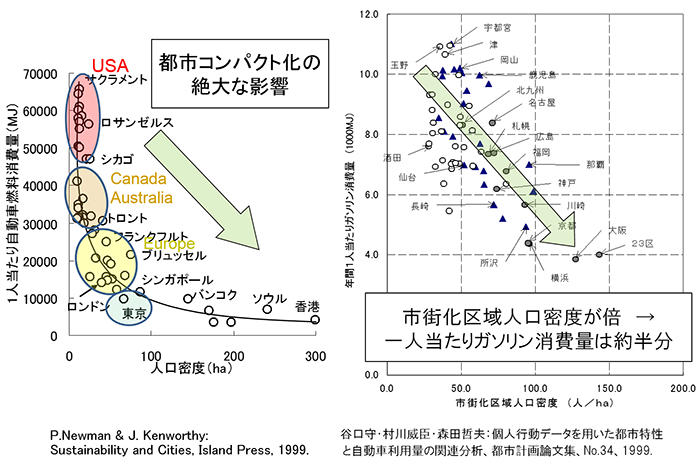
図1:人口密度が高いほど自動車燃料消費量は下がる
しかし、日本においてコンパクトシティという概念が具体的に政策に反映されるまでには長い道のりが必要でした。欧州では1980年代後半からコンパクトシティ政策が実務に反映され始めましたが、日本では2000年以前に中央官庁でそのような議論が行われた形跡すらなかったのです。私たちは中央官庁や学会に対し、データを用いて都市コンパクト化の必要性を示すとともに(図1)、コンパクト化の概念が正しく理解されるための情報発信を行ってきました(図2)。
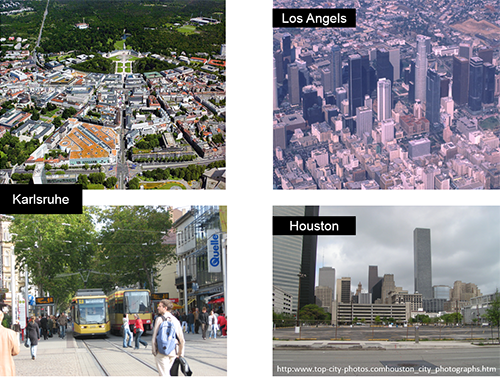
図2:コンパクト化とは単なる高層化ではなく、自動車燃料消費量を下げ中心部ににぎわいを生む都市構造を形成すること
大勢の関係者の努力が実を結び、都市コンパク化の重要性は次第に日本国内で認識され始め、政策に反映されてきました。2000年以降いくつかの転換点がありましたが、2014年8月に「都市機能誘導区域」等の制度が施行されたことは、日本の都市コンパクト化を推進するうえで歴史的な転換点になるでしょう(図3)。
しかし、現実に人が暮らしている地域で都市をコンパクト化していくためには、まだまだ越えなければならない課題が存在します。私たちは、引き続きこれらの課題を明確にし、乗り越えていくための方法論を提示することに取組んでいきます。
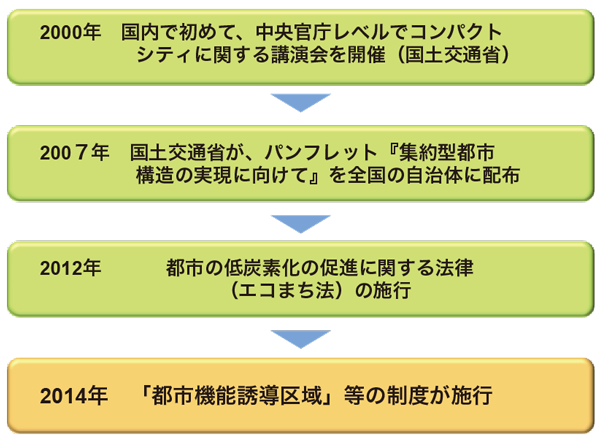
図3:日本におけるコンパクトシティ政策の流れ
社会への貢献・実績
- 政府や地方自治体のコンパクトシティ政策への提言、参画
- 実際の社会動向を踏まえた実践的大学院教育
取材:平成26年12月22日
Desired forms of city
Unit members : OKUSHIMA Shinichiro Okamoto, Naohisa Akiyama, Eizo Osawa, Yoshiaki Taniguchi Ayako Tsutsumi, Morito Suzuki, Tsutomu
Unit name: Compact City
Key words: compact cities, sustainability, foundation of society, Ökumene, land use
 In recent years, the concept of compact cities has been receiving attention in relation to urban planning in Japan. Why has this concept been the center of attention? What effect is the downsizing of cities expected to have? What problems does it have? The research unit: “Compact City”, consisting of specialists from many different fields, suggests specific methods for downsizing, and solutions for their implementation.
In recent years, the concept of compact cities has been receiving attention in relation to urban planning in Japan. Why has this concept been the center of attention? What effect is the downsizing of cities expected to have? What problems does it have? The research unit: “Compact City”, consisting of specialists from many different fields, suggests specific methods for downsizing, and solutions for their implementation.
Reviewing the forms of cities
The development of many urban cities in Japan following World War II can be characterized as being automobile dependent. Increases in the populations of urban cities and their expansion into suburban areas have been associated with increases in the frequency of the use of automobiles. However, a decrease in the population of Japan since 2007 is expected to be further accelerated, and the scale of public finance is bound to become smaller. It will be significantly difficult to continue to provide urban residents with services in all extended suburban areas. Furthermore, it will be necessary to reduce CO2 emissions from the perspective of environmental load reduction. Due to these circumstances, urban planning in Japan has become sustainable, compact city-oriented.
Being at a historic turning point
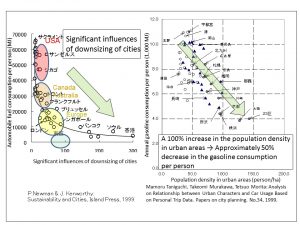
Figure 1: The higher the population density, the lower the vehicle fuel consumption
However, the road to the adoption of the concept of compact cities into specific policies was very long. Whereas European countries started to implement the policies on compact cities in the late 1980s, there are no records to suggest that Japanese central government bureaucrats even discussed the issue. We have explained the necessity of downsizing cities to the central government offices and academic societies (Figure 1), using data, and provided information to help correctly understand the concept (Figure 2).
As a result of the efforts of many people involved, there has been an increase in the awareness of the importance of downsizing urban cities, and it has been adopted into policies. Among several turning points since 2000, the implementation of “Urban Function Induction Areas” and other systems in August 2014 is considered to be an epoch-making event in relation to the promotion of the downsizing of urban cities in Japan (Figure 3).
However, there are still several challenges to be addressed to downsize urban residential areas. We will continue our efforts to identify problems related to the issue, and suggest methodologies to solve them.

Figure 2: The establishment of compact cities refers to the development of the structure of cities in which vehicle fuel consumptions are reduced and the center is bustling with people, rather than the construction of tall buildings.Figure 2: The establishment of compact cities refers to the development of the structure of cities in which vehicle fuel consumptions are reduced and the center is bustling with people, rather than the construction of tall buildings.
Left: Although the city has a population of 200,000 and there are not many high-rise buildings, the center is bustling with pedestrians. Right: The city has a population of three million and many high-rise buildings, and the center is very quiet (the means of transportation is basically automobiles).
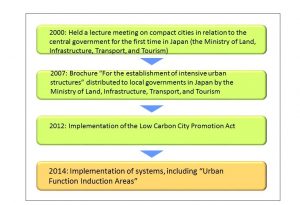
Figure 3: History of compact city policies in Japan
Social contributions and achievements
- Suggestions to and participation in compact city policies developed by central and local governments
- Practical graduate education based on real social trends
Interviewed on December 22, 2015
